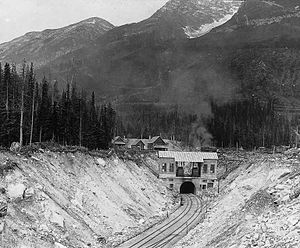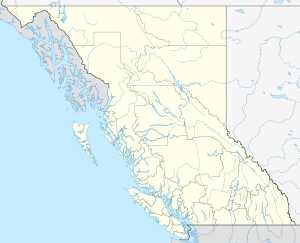Connaught tunnel
| Connaught tunnel | ||
|---|---|---|
|
Entrance to the Connaught Tunnel around 1918
|
||
| use | Railway tunnel | |
| place | near Rogers Pass in the Selkirk Mountains | |
| length | 8082 m | |
| Number of tubes | 1 | |
| construction | ||
| start of building | July 1, 1913 | |
| completion | December 16, 1916 | |
| business | ||
| operator | Canadian Pacific Railway | |
| location | ||
|
|
||
| Coordinates | ||
| East portal | 51 ° 19 '50 " N , 117 ° 26' 49" W. | |
| West portal | 51 ° 16 ′ 8 " N , 117 ° 30 ′ 42" W. | |
The Connaught Tunnel is a railway tunnel on the Canadian Pacific Railway (CPR) in the Canadian Rockies . It lies between Calgary (Province of Alberta ) and Revelstoke (Province of British Columbia ) on the main transcontinental route Montreal - Vancouver and passes under the Rogers Pass and Mount Macdonald in the Selkirk Mountains . Internally in CPR, the section in which the tunnel is located is called the Mountain Subdivision .
The 8082 meter long tunnel is named after Arthur, 1st Duke of Connaught and Strathearn , the Governor General of Canada . It was built because the route over the pass became too steep for the increasingly longer freight trains, as well as extreme snow depths and avalanche hazards. In the avalanche accident of 1910, 62 railway workers were killed. The tunnel has a gradient of 0.95% and is entirely straight, i.e. That is, from one tunnel entrance you can see the light at the other end.
The project was put out to tender in February 1913 and on July 1, 1913 the contract went to the construction company Foley Bros. Welch and Stewart. Several side tunnels were drilled from a small auxiliary tunnel to the actual main tunnel. This made it possible to build in several places at the same time. The construction company promised a monthly advance of 270 meters and began work on April 2, 1914. The tunnel was completed before the originally set date and was first driven on December 16, 1916. At the time, it was the longest rail tunnel in North America .
The construction cost was 5.5 million Canadian dollars . Another three million were used to dismantle the 23.3-kilometer stretch over the pass and to build a new access route to the tunnel portals and avalanche protection walls with a length of 6 kilometers. Overall, the route was shortened by 6.9 kilometers.
Problems during operation caused the ventilation, loose rock and wet rails that caused the trains to slide. Later the tunnel was lined with concrete and received a better ventilation system. The originally two-lane tunnel was reduced to one lane in 1959; Thanks to the larger clearance profile , taller freight trains could pass through the tunnel.
In 1988, the 90 meters lower and 14.7 kilometers long Mount Macdonald Tunnel was opened to complement the Connaught Tunnel. Operations are normally regulated so that only eastbound trains use the Connaught Tunnel, while trains heading west use the Mount Macdonald Tunnel.
literature
- Gary G. Backler, Trevor D. Heaver: The timing of a major investment in railway capacity. CPR's 1913 Connaught-Tunnel decision . In: Business History , Vol. 24 (1982), Issue 3, pp. 300-314, ISSN 0007-6791
- William Lowell Putnam: Great railroad tunnels of North America . McFarland, Jefferson, NC 2011, ISBN 978-0-7864-5951-3 , pp. 129-151.
Individual evidence
- ↑ Mountain Subdivision , (English)


